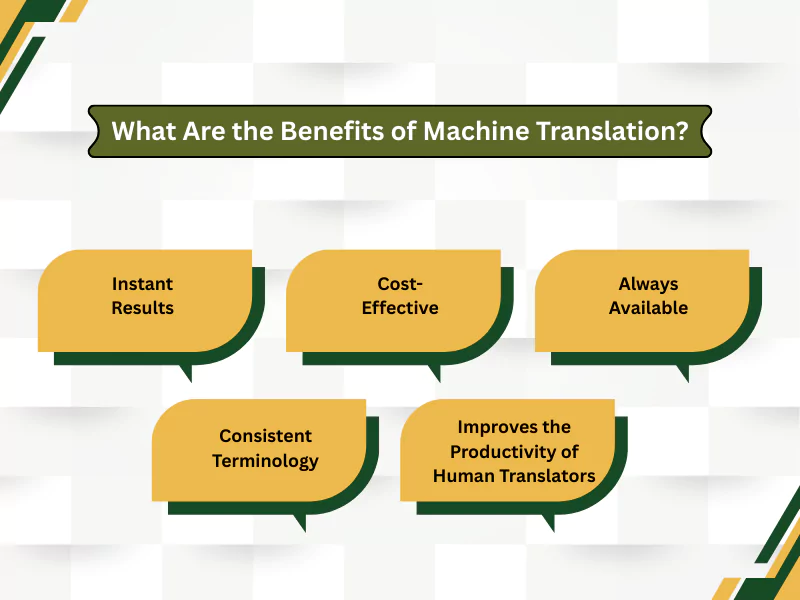Machine translation has made many things easier for everyone. Today, we don’t face a problem navigating through reviews on an international e-commerce website. Further, you can simply use Google Translate to read a newspaper in a foreign language. All of these are possible because of machine translations.
But what is machine translation? While it is clear that these are possible with the use of technology, it is not clear how it is utilised and its benefits. This blog aims to clear the air. We will take you through the meaning, benefits, and how translation companies use it to expedite the translation process.
What Is the History of Machine Translation: Definition and Overview

Machine translation refers to the use of computer software (artificial intelligence) to translate text or speech from one language to another, with minimal or no human involvement. The technology uses artificial intelligence and natural language processing to understand, process, and convert language. A computerised system of machine translation was not developed until the early 2000s.
The automated translation process utilises both rule-based machine translation and advanced neural machine translation (NMT) to convert text from one language to another. The process is entirely computerised and differs from computer-assisted translation.
In computer-assisted translation (CAT), tools are used to help human translators work more efficiently, consistently, and accurately by facilitating proper text segmentation. The CAT machine translation tools also provide translation memories (TMs) of previously translated content, manage glossaries, and perform assurance checks. It can also reuse the terms whenever needed.
In simple terms, machine translation technology involves translating speech or text from one language to another without human intervention. That brings us to the question: how does machine translation work? The following section will give you an insight into the process.
How Machine Translation Works? Different Approaches and the Technical Process
A. Rule-Based Machine Translation
One of the early approaches, rules-based machine translation, relies on complex sets of linguistic rules and dictionaries created by language experts. In this approach, the technology analyzes the source text and generates an intermediate representation that accurately reflects the text’s meaning and grammar. It then converts the text into the target language using reference rules and glossaries.
B. Statistical Machine Translation
The statistical machine translation approach uses large databases of existing translations. The system then employs statistical methods to predict the most likely language translation of a given sentence or phrase. The system uses patterns and correlations it discovered in bilingual texts to translate a sentence or phrase.
C. Neural Machine Translations
In this approach, the system uses deep learning and AI neural networks to understand the context and meaning of the given text. This helps the system deliver results with improved fluency and accuracy. The system analyses sentences as a whole, rather than examining them word by word, thereby facilitating more natural translations.
D. Hybrid Machine Translation
The hybrid models combine elements of all the above approaches to maximise accuracy and flexibility in use cases.
Machine translation is continually improving. The following is the technical process to clarify the process further:
How to Use Machine Translation
The system follows a three-step process:
- Preprocessing – In the first step, the source text is prepared by filtering for clarity, removing unclear language, standardising terminology to improve translation accuracy, and reducing errors.
- Translation engine – The selected machine translation model analyses the text, using its combination of rules, statistical evidence, or neural logic to create a first draft of the translation.
- Post-editing and quality control – Although the process involves less human involvement, this step requires professional translators to review the results. They ensure the result is grammatically correct, follows the correct style, and is culturally relevant.
The best AI translation tools follow the above process to deliver accurate results. However, since there’s less human involvement, the fear of misinterpretation is also high. On that note, let’s understand how machine translation is beneficial despite the fear of misinterpretation.
What Are the Benefits of Machine Translation Technology?

There are numerous benefits of machine translation. Numerous companies utilise machine translation for the conversion of text from one language to another without human involvement. The following are a few of the major benefits of MT you must know about:
A. Instant Results
The best thing about using a translation software is that it can process a high volume of data and millions of words in seconds. It can deliver the translation output in a short time, making it the best choice for projects with tight deadlines and real-time customer support chats.
B. Cost-Effective
Translation software drastically reduces translation costs since it eliminates the need for human translations. Companies utilise machine translation for high-volume or routine content to achieve AI Localization scalable solutions without compromising efficiency.
C. Always Available
You can use machine translation tools at any time. The tools help get instant solutions from anywhere and at any time.
D. Consistent Terminology for Reuse
Machine translation tools use translation memories and glossaries to ensure consistency in terminology. It helps in maintaining consistent brand-specific terms and styles across all business documents.
E. Improves the Productivity of Human Translators
Translators use machine translation to create the first draft. This helps them focus on cultural nuances and creative aspects while editing the draft.
Additionally, machines have the capability to perform back translations, further helping professional translators to translate a document back to its original form.
What Are Some Use Cases of Machine Translation?
The various machine translation methods are used in various business cases. Here are a few use cases to help you relate to the uses of machine translation:
A. Customer Support
Several companies use machines for live chat support, email, and support ticket systems for providing real-time assistance in a number of languages. This helps improve customer satisfaction without bearing any additional cost on staffing.
B. Content Localisation
Content localisation uses machine learning technologies to speed up the translation process of websites, marketing materials, e-learning modules, product descriptions, etc. The process helps companies customise content in different languages quickly without incurring significant costs.
C. Internal Communications
Machine translation methods aid in internal communications by translating emails, reports, and internal documentation, ensuring that everyone in a team understands the content for improved workflow.
D. Technical Content
MT proves to be an effective method to translate technical documents and user manuals. The focus on these documents is to convey instructions and intent. However, human editing is often necessary for this content.
E. Education and Training
Technology-based translations are effective for educational and training purposes, as they help create content that accommodates diverse multilingual workforces.
Machine translations support different types of translations. However, the need for human translators cannot be overlooked. In the following section, we will help you understand the importance of human translators throughout the entire process.
An Insight into Where Human Translation Fits in
You must understand that machine translation does not replace human translators; rather, it assists them in the process. Here’s how professionals who are fluent in different languages fit into the translation process:
Post Editing Machine Translation
This is a hybrid approach where a professional translator, associated with a translation service provider, edits the translation output to refine the output and ensure it fits the context of the original language. It ensures accurate translation of the original text, and is mostly applicable for:
- Technical documentation
- Knowledge bases
- Legal translations
- All other contents where speed and volume are essential
Additionally, if you are concerned about the prices, here’s a table with the reasons the prices are different for human translation:
| Translation Type | Price per Word | Certification | Quality Assurance | Delivery Speed |
|---|---|---|---|---|
| Machine Translation | $0.01–$0.05 | Not certified | None/Basic | Instant/Minutes |
| Human (Australian NAATI) | AUD 0.10 | NAATI certified | Expert review | A few hours |
That will help you understand the need for translation service providers and why you still need professionals for accuracy and higher-quality translations, considering the complexity of translations. Translation may not be accurate when done by machines.
Conclusion: Embracing a Powerful Collaboration
The future of translation appears brighter with the powerful combination of machine and human translations. While machine translations save a lot of time, they are yet to be considered a perfect tool for translation. The tools can translate numerous user-generated data and translate them accurately in seconds. However, it may fail to grasp the context and cultural nuances.
The human brain can help translate content customised to a specific audience. Using a computer to do the groundwork makes the entire process easier for humans. That is what is expected in the near future: a potent combination of humans and machines for faster and more accurate translations.
If you are willing to translate a large number of documents, consider using both machines and humans to achieve accurate results.
Frequently Asked Questions
What is an example of a machine translation tool?
One of the most popular and widely used machine translation tools is Google Translate. It supports over 100 languages, covering both speech and text translation.
Is AI considered machine translation?
Yes, AI is considered a machine translation. Modern machine translation uses AI, especially neural networks and deep learning.
Can I use ChatGPT to translate in real time?
Yes, you can use ChatGPT for real-time translation. However, AI does not guarantee the accuracy of translations. It is therefore recommended that you avail translation services for official and legal documents.
What is the difference between AI and MT?
AI is a broad field of computer science that helps create systems that can perform intelligent tasks. MT is a specific application of AI that uses automated processes to translate text or speech.
What is machine translation in NLP techniques?
Machine translation is an NLP technique focused on translating text or speech from one language to the other automatically. It uses various algorithms to do the task.
Can machine translation replace human translation?
No, machine translation cannot replace human translators. Machines lack the understanding of context and various cultural nuances, making the translations less accurate compared to human translations.
Are there any challenges to using machine translations?
Yes, there are a few challenges to using machine learning, such as:
- Accuracy and quality issues
- Contextual and cultural limitations
- Technical and practical concerns
- Privacy and security risks
- Language Disorder or Language Difference: How to Know? - November 29, 2025
- AI Localization and Automation: Best Practices for Translation - November 13, 2025
- Australian Work Visa: Get Approved Fast with This Step-by-Step Guide! - October 28, 2025







